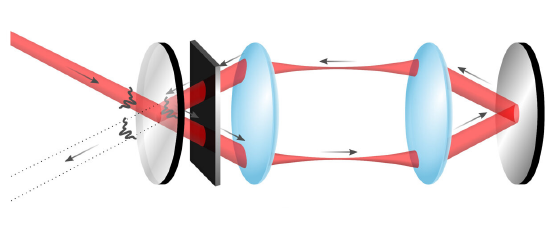博文
物理学家开发了一种完美的光阱
||
物理学家开发了一种完美的光阱
诸平
Fig. 2 Image of the experimental setup in the lab at The Hebrew University of Jerusalem
据奥地利维也纳理工大学(Vienna University of Technology / Technische Universität Wien 简称 TU Wien)2022年8月25日提供的消息, 物理学家开发了一种完美的光阱(Physicists develop a perfect light trap)。图中显示了“光阱(light trap)”装置,由一个部分透明的反射镜、一个薄而弱的吸收体、两个会聚透镜和一个全反射镜组成。通常,大多数入射光束会被反射。然而,由于精确计算的干涉效应,入射光束与反射镜之间反射回来的光束发生干涉,因此反射光束最终完全熄灭。光的能量被薄而弱的吸收体完全吸收。
无论是在光合作用中还是在光伏系统中:如果你想有效地利用光,你必须尽可能地完全吸收光。然而,如果吸收发生在通常允许大部分光通过的薄层材料中,则很难做到这一点。
现在,维也纳理工大学(TU Wien)和耶路撒冷希伯来大学(The Hebrew University of Jerusalem)的研究团队发现了一个惊人的技巧,使光束即使在最薄的层中也能被完全吸收:他们使用镜子和透镜在薄层周围构建了一个“光阱”,其中光束被引导成一个圆,然后以这样的方式完全叠加在自身上,光束会阻挡自身,不再离开系统。因此,光除了被薄层吸收之外别无选择,没有其他出路。相关研究结果于2022年8月25日已经在《科学》(Science)杂志网站发表——Yevgeny Slobodkin, Gil Weinberg, Helmut Hörner, Kevin Pichler, Stefan Rotter, Ori Katz. Massively degenerate coherent perfect absorber for arbitrary wavefronts. Science, 25 Aug 2022, 377 (6609): 995-998. DOI: 10.1126/science.abq8103. https://www.science.org/doi/10.1126/science.abq8103
发表在《科学》杂志上的这一吸收放大方法,是两个团队卓有成效合作的结果:该方法由耶路撒冷希伯来大学的奥里·卡茨(Ori Katz)教授提出,并由TU Wien的斯特凡·罗特(Stefan Rotter)教授构思;实验是由耶路撒冷的实验室团队进行的,而理论计算来自维也纳的团队。
薄层对光是透明的(Thin layers are transparent to light)
TU Wien理论物理研究所(Institute of Theoretical Physics at TU Wien)的斯特凡·罗特教授说:“当光照射到固体物体时很容易吸收。一件厚的黑色羊毛套头衫可以很容易地吸收光线。但在许多技术应用中,你只有一层薄薄的材料,你希望光线正好被这一层吸收。”
已经有人尝试改善材料的吸收:例如,可以将材料放置在两个镜子之间。光在两个镜子之间来回反射,每次都穿过材料,因此被吸收的机会更大。然而,为了达到这个目的,镜子不能是完美的,其中一个必须是部分透明的,否则光线根本无法穿透两个镜子之间的区域。但这也意味着,每当光线照射到这面部分透明的镜子时,部分光线就会丢失。
光线自身受阻(The light blocks itself)
为了防止光线丢失这种情况发生,可以通过复杂的方式使用光的波特性。耶路撒冷希伯来大学的奥里·卡茨教授说:“在我们的方法中,我们能够通过波的干扰消除所有的反向反射。”TU Wien的赫尔穆特·霍纳(Helmut Hörner)将他的论文专注于这一主题,他解释道:“在我们的方法中,光首先落在部分透明的镜子上。如果你简单地将激光束发送到这面镜子上,它会分为两部分:较大的部分被反射,较小的部分穿透镜子。”
穿透镜子的这部分光束现在通过吸收材料层,然后通过透镜和另一面镜子返回到部分透明的镜子。耶夫根尼·斯洛博德金(Yevgeny Slobodkin)和吉尔·温伯格(Gil Weinberg)是在耶路撒冷建造该系统的两名研究生,他们说:“关键在于,这条路径的长度和光学元件的位置的调整方式,使得返回的光束(以及镜子之间的多次反射光)正好抵消了直接反射在第一面镜子上的光束。”
可以这么说,两束部分光束以这样一种方式重叠,光会挡住自己即光线自身受阻:尽管仅部分透明的镜面实际上会反射大部分光,但这种反射是不可能的,因为光束的另一部分穿过系统,然后回到部分透明的镜面。
因此,过去是部分透明的镜子,现在对入射激光束已完全透明了。这为光束创建了一条单行道:光束可以进入系统,但由于反射部分和通过系统引导的部分在一个圆圈中重叠,因此它不能再逃逸。所以,光束除了被吸收之外,别无选择。整个激光束被一层薄薄的薄膜吞没,否则大部分激光束都会通过。
一种稳健的现象(A robust phenomenon)
斯特凡·罗特说:“系统必须精确地调整到你想要吸收的波长。但除此之外,没有限制要求。激光束(laser beam)不必有特定的形状,它在某些地方的强度可能比在其他地方更高。几乎总是能实现完美的吸收。”
耶路撒冷希伯来大学进行的实验表明,即使是空气湍流(air turbulence)和温度波动也不会损害这种机制。这证明了它是一种稳健的效应,有着广泛的应用前景。例如,所提出的机制甚至可以很好地捕捉在穿过地球大气层传输过程中失真的光信号。
这种新方法在实际应用中也是很有用的,它可以将微弱光源(如遥远的恒星)的光波最佳地送入探测器。
上述介绍,仅供参考。欲了解更多信息,敬请注意浏览原文或者相关报道。
The absorption of light is important in many natural processes and device applications. Although absorbing a little bit of light is easy, absorbing all of it is generally difficult to achieve. However, the process of coherent perfect absorption, an interferometric effect, showed that light of a very specific spatial mode could be perfectly absorbed if it was matched precisely to the properties of a cavity. Slobodkin et al. now extend the concept to multimode coherent perfect absorption (see the Perspective by Bertolotti). Using a self-imaging cavity design, they demonstrate that complex spatial modes can be absorbed almost perfectly. —ISO
One of the key insights of non-Hermitian photonics is that well-established concepts such as the laser can be operated in reverse to realize a coherent perfect absorber (CPA). Although conceptually appealing, such CPAs are limited so far to a single, judiciously shaped wavefront or mode. Here, we demonstrate how this limitation can be overcome by time-reversing a degenerate cavity laser based on a unique cavity that self-images any incident light field onto itself. Placing a weak, critically coupled absorber into this cavity, any incoming wavefront, even a complex and dynamically varying speckle pattern, is absorbed with close to perfect efficiency in a massively parallel interference process. These characteristics open up interesting new possibilities for applications in light harvesting, energy delivery, light control, and imaging.
https://m.sciencenet.cn/blog-212210-1353005.html
上一篇:开发安全、清洁、无碳能源的障碍具有惊人的吸引力
下一篇:量子热泵:物理学家的一种新测量工具

